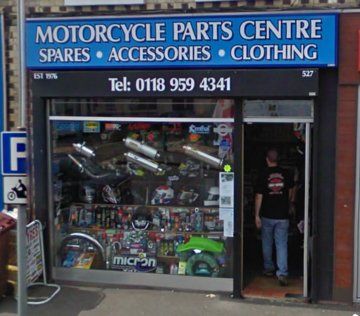Discover Affordable Costs on Motocross Parts NZ for every single Bike
Discover Affordable Costs on Motocross Parts NZ for every single Bike
Blog Article
Understanding the Crucial Parts of a Motorcycle: A Comprehensive Overview for Lovers
For motorbike enthusiasts wanting to elevate their riding experience and guarantee their bikes run smoothly, understanding the necessary parts of a bike is extremely important. Each element, from the engine's detailed functions to the important function of the braking systems, not only affects performance but also safety and comfort. This overview will walk through the basic parts that every motorcyclist need to recognize with, allowing notified choices in both maintenance and prospective upgrades. As we start this exploration, one must ask: exactly how does each element interact to produce the seamless trip every enthusiast seeks?
Engine Elements

The camshaft plays an essential duty in controlling the timing of the engine's shutoffs, making certain the specific opening and closing needed for efficient gas and air consumption, along with exhaust expulsion. This timing is vital to maintaining ideal engine efficiency and performance. Furthermore, the carburetor or gas shot system, depending on the motorbike version, is accountable for mixing air with gas in the correct ratio for combustion.
The cooling system, either air or liquid-based, functions to maintain the engine's temperature within functional limits, protecting against getting too hot and ensuring durability - motorbike shop. Each element, meticulously developed and integrated, adds to the seamless procedure of the engine, specifying the motorcycle's power output and overall efficiency
Transmission System
Important to the motorcycle's capability, the transmission system guarantees effective power transfer from the engine to the wheels. This system consists of a number of important parts, consisting of the clutch, transmission, and final drive, each playing an important function in translating the engine's power right into motion. The clutch, normally operated by a hand bar, offers to involve and disengage the engine from the transmission, permitting smooth equipment adjustments and controlled velocity.
The transmission, typically described as the transmission correct, has a collection of gears that motorcyclists can manually change via to readjust the bike's speed and torque output. These equipments are arranged in a sequence that makes it possible for the motorbike to accelerate smoothly and maintain optimum engine performance across numerous speeds. Most motorcycles utilize a consecutive transmission, calling for the rider to move equipments in an established order.
Braking Devices
While comprehending the transmission system is crucial to utilizing a bike's power, similarly important is the ability to control and quit that power properly, which is where stopping devices come into play. Brakes are critical for security and efficiency, providing the rider with the essential control to browse numerous terrains and problems. Commonly, motorcycles include 2 kinds of stopping systems: disc brakes and drum brakes.
Disc brakes are a lot more widespread in modern motorcycles because of their exceptional efficiency. They consist of a brake disc, caliper, and pads. When turned on, the caliper presses the brake pads against the rotating disc, transforming kinetic power right into heat, consequently slowing down the wheel. This system provides far better heat dissipation, regular efficiency, and improved stopping power, especially in damp conditions.
Conversely, drum brakes, though much less usual, are still found in some bikes. They function cool motorcycle helmet designs by pressing brake footwear against the internal surface of a drum affixed to the wheel. While generally much less effective in warmth dissipation and stopping power, drum brakes are less complex and more affordable.
Understanding these braking systems' subtleties permits motorcyclists to keep their motorbikes appropriately and value the engineering that ensures effective and risk-free stopping.
Suspension and Steering
Suspension and guiding systems are crucial parts that dramatically influence a bike's handling and trip convenience. The suspension system, containing forks at the front and shock absorbers at the back, absorbs road abnormalities, boosting stability and control. Front forks, upside down or typically telescopic, compress and rebound to reduce effects, while rear shock absorbers maintain tire call with the roadway, important for traction and safety.
Guiding, focused around the handlebars, links the biker to the motorcycle's directional control. The guiding head bearings ensure smooth procedure, allowing specific ability to move. Correct positioning and maintenance of these bearings are essential for predictable steering feedback and lowering rider fatigue.
The suspension's adjustability is one more critical aspect; preload, damping, and rebound settings enable personalization to match numerous riding designs and conditions. This flexibility is important for optimizing efficiency, whether navigating city streets or taking on tough trails. Technologies like electronic shock absorber use real-time adjustments, boosting experience quality throughout diverse surfaces.

Electrical Systems
After guaranteeing a smooth and regulated trip through efficient suspension and steering systems, attention transforms to the electric systems, a crucial facet of contemporary motorcycles. These systems play an important duty not just in beginning the engine but likewise in powering numerous components that improve the functionality and safety and security of the motorbike.
At the link heart of a motorcycle's electric system is the battery, which stores electric power needed for starting the engine and powering auxiliary systems - motorcycle shop. The alternator or generator, coupled with the rectifier-regulator, guarantees the battery stays charged while the motorbike is in operation, converting mechanical energy into electric energy and keeping voltage levels
The ignition system, another crucial component, is responsible for stiring up the air-fuel combination in the engine's cyndrical tubes. Modern motorbikes commonly make use of an electronic ignition system, offering higher performance and integrity compared to standard systems.
Lighting systems, consisting of fronts lights, tail lights, and indications, are additionally vital, guaranteeing presence and safety and security for the motorcyclist. Additional digital parts such as sensors, control systems, and shows contribute to advanced attributes like fuel injection administration, anti-lock stopping systems (ABDOMINAL MUSCLE), and electronic control panels, additionally boosting the riding experience.
Final Thought
A thorough understanding of a motorbike's necessary elements, including the engine, transmission system, braking mechanisms, suspension, steering, and electric systems, is essential for lovers aiming to maximize performance, comfort, and safety and security. Mastery of these elements allows for notified choices pertaining to upkeep and upgrades, inevitably enhancing the riding experience. By incorporating this expertise, riders can guarantee their bikes operate at peak performance and integrity, consequently maximizing both enjoyment and durability of their vehicles.
For motorcycle enthusiasts looking to raise their riding experience and ensure their bikes run efficiently, recognizing the vital parts of a bike is vital.Integral to the motorcycle's capability, the transmission system guarantees efficient power transfer from the engine to the wheels.While understanding the transmission system is crucial to taking advantage of a motorcycle's power, just as crucial is the capability to control and quit that power effectively, which is where stopping mechanisms come into play. Normally, bikes feature 2 types of stopping systems: disc brakes and drum brakes.
A complete understanding of a motorbike's necessary elements, including the engine, transmission system, stopping mechanisms, suspension, steering, and electrical systems, is click here to find out more indispensable for fanatics intending to optimize safety, performance, and comfort.
Report this page